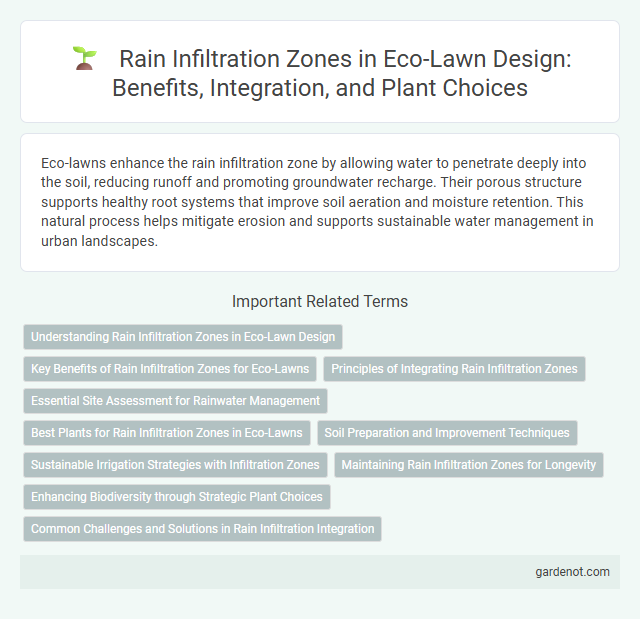Eco-lawns enhance the rain infiltration zone by allowing water to penetrate deeply into the soil, reducing runoff and promoting groundwater recharge. Their porous structure supports healthy root systems that improve soil aeration and moisture retention. This natural process helps mitigate erosion and supports sustainable water management in urban landscapes.
Understanding Rain Infiltration Zones in Eco-Lawn Design
Rain infiltration zones in eco-lawn design are critical areas where soil permeability facilitates efficient water absorption, reducing surface runoff and promoting groundwater recharge. These zones typically feature porous soil compositions and grading techniques that direct rainfall to permeable sections, enhancing moisture retention needed for sustainable turf growth. Implementing well-designed infiltration zones supports ecosystem health by mitigating erosion and improving water quality through natural filtration processes.
Key Benefits of Rain Infiltration Zones for Eco-Lawns
Rain infiltration zones in eco-lawns significantly enhance groundwater recharge by allowing rainwater to permeate the soil efficiently, reducing surface runoff and erosion. These zones improve soil health and plant growth by maintaining optimal moisture levels, which supports drought resilience and reduces the need for supplemental irrigation. Implementing rain infiltration zones also decreases the burden on stormwater systems, mitigating urban flooding and promoting sustainable water management.
Principles of Integrating Rain Infiltration Zones
Rain infiltration zones in eco-lawns enhance stormwater management by promoting natural water absorption and reducing runoff. These zones utilize permeable soil layers combined with drought-resistant grasses and native plants to maximize water infiltration and improve soil health. Effective integration involves zoning key areas such as slopes and depressions, ensuring optimal placement for seasonal water capture and gradual groundwater recharge.
Essential Site Assessment for Rainwater Management
Rain infiltration zones are critical in eco-lawn design to maximize groundwater recharge and reduce surface runoff. Essential site assessment includes analyzing soil permeability, topography, and existing vegetation to determine optimal placement and size of infiltration areas. Proper evaluation ensures efficient rainwater management, promoting sustainable water cycles and preventing erosion.
Best Plants for Rain Infiltration Zones in Eco-Lawns
Native grasses such as fine fescue (Festuca spp.) and buffalo grass (Bouteloua dactyloides) excel in rain infiltration zones within eco-lawns due to their deep root systems that enhance soil permeability. Sedges, including Carex species, are also ideal for these areas as they tolerate periodic soil saturation while improving water absorption and filtration. Incorporating drought-tolerant wildflowers like purple coneflower (Echinacea purpurea) further supports rain infiltration by promoting biodiversity and maintaining soil structure in eco-lawn environments.
Soil Preparation and Improvement Techniques
Effective soil preparation in rain infiltration zones involves loosening compacted soil to enhance permeability and increase water absorption rates. Incorporating organic matter such as compost improves soil structure, nutrient retention, and microbial activity, promoting healthier root growth in eco-lawns. Implementing techniques like aeration and the use of biochar further optimize soil porosity and water infiltration, reducing runoff and supporting sustainable lawn ecosystems.
Sustainable Irrigation Strategies with Infiltration Zones
Rain infiltration zones are critical components of eco-lawn design, promoting sustainable irrigation by enhancing water absorption directly into the soil. These zones utilize permeable surfaces and native vegetation to reduce runoff, increase groundwater recharge, and improve soil moisture retention. Integrating infiltration zones within eco-lawns supports efficient water use, minimizes irrigation needs, and helps maintain healthy, drought-resistant turf.
Maintaining Rain Infiltration Zones for Longevity
Maintaining rain infiltration zones is crucial for enhancing eco-lawn sustainability by promoting effective water absorption and reducing surface runoff. Regularly aerating the soil and avoiding compaction preserve infiltration capacity, supporting healthy root growth and drought resistance. Incorporating organic matter into these zones improves soil structure and water retention, ensuring long-term ecological benefits.
Enhancing Biodiversity through Strategic Plant Choices
Designing rain infiltration zones within eco-lawns using diverse native grasses and wildflowers enhances soil permeability and supports local wildlife habitats. Strategic plant choices, such as deep-rooted species and flowering perennials, improve water absorption while providing food and shelter for pollinators and beneficial insects. This approach increases biodiversity, promotes ecosystem resilience, and reduces runoff pollution.
Common Challenges and Solutions in Rain Infiltration Integration
Rain infiltration zones in eco-lawns often face common challenges such as soil compaction, inadequate permeability, and poor drainage, leading to surface runoff and reduced groundwater recharge. Implementing solutions like amending soil with organic matter, using permeable substrates, and integrating drainage systems can enhance water absorption and retention. Properly designed rain infiltration zones promote sustainable stormwater management while supporting healthy turf growth and reducing environmental impact.
Rain infiltration zone Infographic

 gardenot.com
gardenot.com